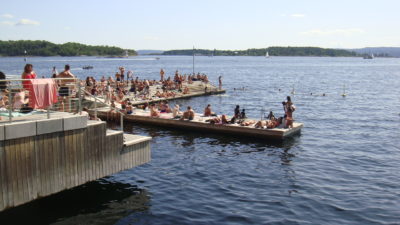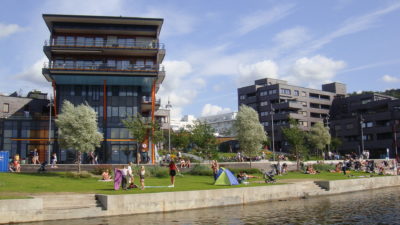More conflicts have erupted in Oslo this summer between those who’ve paid a fortune for new homes on the fjord and members of the general public, who have a right to waterfront access. That right is often exercised in the form of noisy outdoor summer parties that extend long into night, and right outside homeowners’ bedroom windows.

The conflicts have become most heated at the new Sørenga and Tjuvholmen waterfront redevelopment projects, which now feature some of the most expensive residential units in the Norwegian capital. It’s not unusual to see units bought and sold for as much as NOK 20 million or much more at Tjuvholmen, which, like Sørenga, is a former harbour, shipyard- and industrial area where outdoor recreation was unthinkable just a few decades ago.
Now both complexes feature high-end commercial and residential property and new cultural institutions. While Tjuvholmen on the western side of Oslo’s harbour can boast the Astrup-Fearnley Museum of Modern Art, Sørenga lies adjacent to the new Munch Museum, the Opera and Oslo’s new city library in the eastern harbour district know as Bjørvika. They all draw the public, in addition to those working and now living there.

That’s what’s led to the current conflicts. Developers of both projects won the rights to build luxury condominiums, offices, shops and restaurants in return for opening some new surrounding piers and artificial beaches to the public. Architect Niels A Torp claims he and his colleagues simply didn’t foresee what magnets they’d be for the public, or how badly the public can behave.
“The question is whether it’s possible to find architectural solutions that will prompt people to intuitively behave well,” Torp told newspaper Aftenposten just before the weekend, when the rowdiness at Sørenga and Tjuvholmen subsided only because of pouring rain and cool temperatures that discouraged sunbathing and loud beach parties.
Torp has been behind earlier popular projects like Tjuvholmen’s adjacent Aker Brygge residential complex, Oslo’s main airport at Gardermoen and the Olympic ice skating arena built to look like an overturned Viking ship at Hamar. His credentials and plans for Tjuvholmen left him the winner of the city’s architectural contest for the project that broke ground in 2005 and was mostly finished by 2013. Aker Brygge didn’t offer any swimming facilities, though, and they’re the source of the noisy summer crowds at the two new projects.

Now he and other architects are confronted with the negative effects of their waterfront developments, including drunkenness, vandalism, littering and noise. At Sørenga, many residents are fed up with the crowds and constant partying right outside their homes, and not least with those who use planter boxes or outdoor terraces as public toilets.
Torp told Aftenposten that he now sees in retrospect how there should have been clearer boundaries between areas meant for outdoor recreation and those that were not. More space should have been provided for the public, so that the walkways and piers surrounding the residential buildings wouldn’t be packed with sun worshippers, their towels, picnics and portable music systems.
Rules for use are clearly posted all along what were supposed to be “private” areas of Tjuvholmen, but they’re blatantly ignored when the weather is good. Tjuvholmen’s private security guards try to maintain order but lack legal authority to arrest anyone, and police contend they lack capacity to patrol the waterfront areas.

Bengt Carlson, age 27, was so annoyed when Tjuvholmen’s security guards told him to leave when “I wanted to swim and have a beer” that he wrote a commentary in Aftenposten about his indignation over “fine (waterfront) areas in Oslo” that nonetheless are “subject to private regulations.” When the designated public areas for swimming at Tjuvholmen can’t accommodate the crowds, Carlson thinks he and others should be allowed to spill over into the private areas: “It looks so open and great, but it’s really not for everyone,” he told newspaper Dagsavisen last week as conflicts raged.
Carlson acknowledged that it’s not legal to drink alcoholic beverages outdoors anywhere in Oslo, “but in practice it’s allowed in city parks, so why not at Tjuvholmen? I want the right to violate the rule.” He admitted that residents also had a right to be angry about all the noise and crowds, “but I don’t know where the blame lies, or what they were told before they moved in. The waterfront should be open for everyone.”
Several residents and homeowner associations are now demanding help from the city, especially after their own security guards, rules and efforts to block off pier areas to swimmers have failed. Tove Kirkeng, who lives at Tjuvholmen, is hoping Torp will have some influence and that what Torp calls new “architectural solutions” can dampen the conflict level. She agrees more swimming areas are needed, “but not right outside folks’ bedrooms.”
Torp insists that Tjuvholmen “was supposed to be a fabulous area for everyone, but everyone has responsibility as a user. People must behave well and not be bullish. It’s a completely reasonable demand that residents be allowed to sleep at night.”
Carlson remains skeptical to the entire concept of waterfront real estate projects that are mainly private: “Building so many homes right next to popular swimming areas is completely wrong. We must learn from this when evaluating new projects.”
NewsInEnglish.no/Nina Berglund

